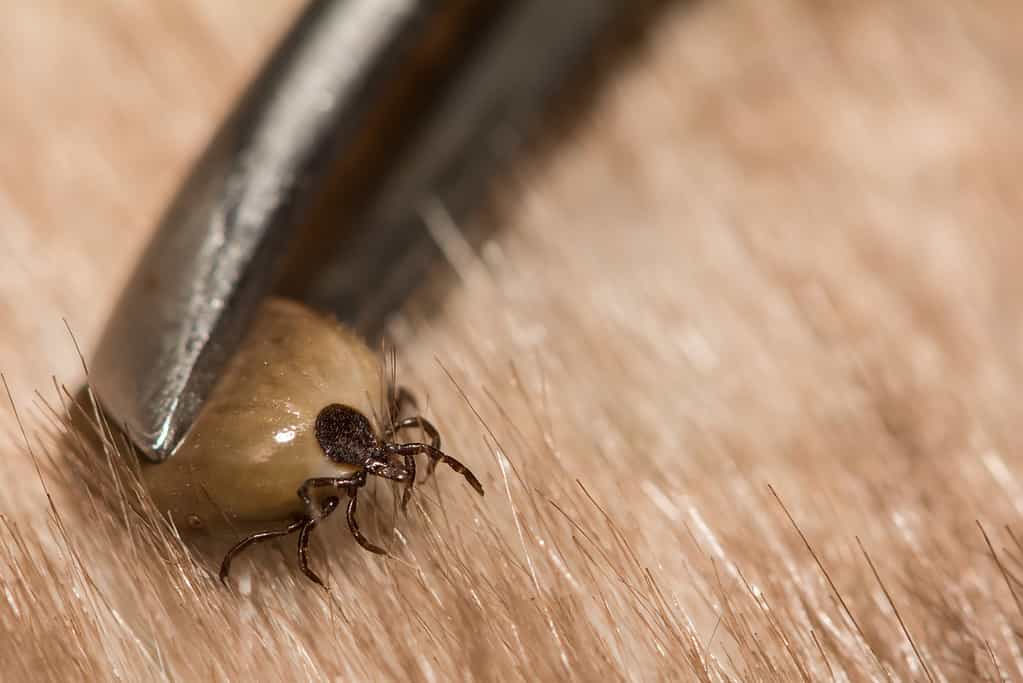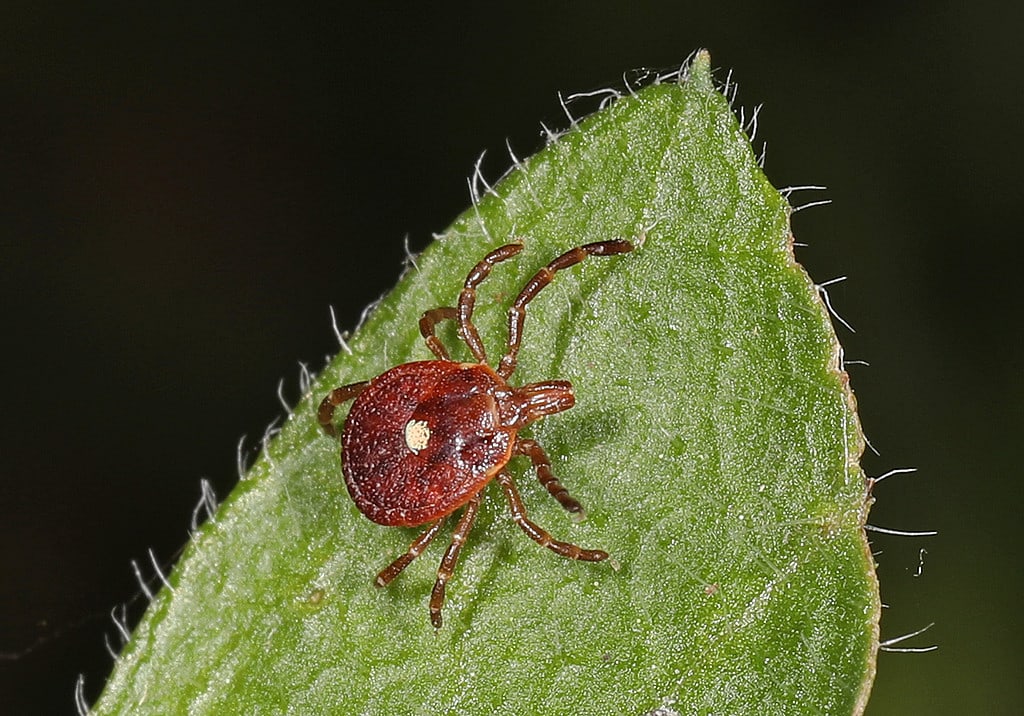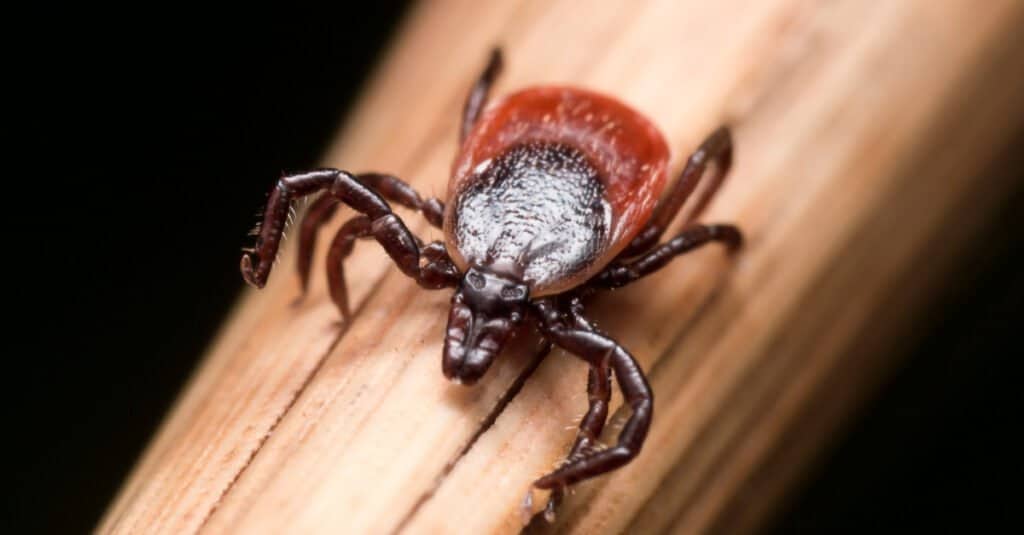Hundreds of different species of ticks are found around the world. Of those, several dozen species can spread pathogens. Since adult female ticks are the primary transmitters, knowing the two key differences between male and female ticks is vital.
But frighteningly, the most dangerous ticks of all can be infinitesimal in size and have no defined gender.
Male vs. Female Ticks
The “shield,” or top plate, that all hard ticks have is called a “scutum.” Its structure is the first key difference between male and female ticks.
In males, this shield covers the entire body. In females, the scutum only covers around one-third of their bodies. Like the Roman shields of antiquity that share the same name, a tick’s scutum is hard, not elastic, and doesn’t change in size.

An engorged female deer tick being removed from a dog. Note that the scutum, or shield, remains the same size.
©JasonOndreicka/iStock via Getty Images
That’s why when you see an engorged female tick, no matter how much blood she has consumed, her scutum will still be the same size. In an engorged — fully-fed — female tick, the scutum will appear to be just a small area near the head and mouthpiece.
Different species of hard ticks have different colors or markings on the scutum. In some, such as the blacklegged, or deer tick, it’s almost a solid black. In others like the American dog tick, the shield will have a pattern and some coloring to it.
Generally speaking, adult male ticks are larger than adult females, until females become engorged with blood from a meal. Ticks are not technically insects, but arachnids. That makes them related to spiders and scorpions.

Even adults, such as this male dog tick, are extremely small.
©NIAID / CC BY 2.0 – License
A Dangerous Difference
Should an adult tick latch on to you or your pet, knowing what kind it is, noting how big it is, and whether it’s a male or female is critical.
A-Z Animals reached out to Alvaro Toledo, Ph.D., a professor at the Department of Entomology, at Rutgers University to explain why that’s so important.
“Ticks transmit diseases when they feed. Males do not feed or take very small blood meals. Thus, they only attach for a short time,” Professor Toledo told us.
“Most pathogens require 36-48 hours to be efficiently transmitted,” Professor Toledo said, “making males unsuitable vectors for transmission.”
Different species of ticks can carry a variety of nasty pathogens. Some ticks are specific to certain locales, and others can be found in large swaths of the U.S. Here’s a list of some of the most commonly encountered ticks in the U.S.
American Dog Tick (Dermacentor variabilis)
Also called the “wood tick,” this tick is found in the U.S. east of the Rocky Mountains and some parts of California and the Pacific Coast. The dog tick is flat and brown or reddish brown, with gray or silver markings on its scutum. Since females only have a partial scutum, they will appear darker in color.
Dog ticks can transmit tularemia (Francisella tularensis) and Rocky Mountain spotted fever (Rickettsia rickettsia)

The American dog tick is flat and brown or reddish brown, with gray or silver markings on its scutum.
©Jerry Kirkhart from Los Osos, Calif. / CC BY 2.0 – License
Brown Dog Tick (Rhipicephalus sanguineus)
Found around the world, including the entire United States, the brown dog tick can also spread Rocky Mountain spotted fever.
Except when the female is engorged, both male and female brown dog ticks are very similar in appearance with flat, reddish-brown bodies. The females are slightly larger than the males.
Like most ticks, when the female becomes engorged with blood, its color will change to a grayish blue.
Lone Star Tick (Amblyomma americanum)
The lone star tick is found throughout the Eastern U.S. from southern Maine to Florida and west to parts of Nebraska and Texas. The female is easily recognized by the white dot on her back. Males will be reddish brown, somewhat smaller than the females, and won’t have the distinguishing center-body small white circle.
Lone star ticks can carry a virtual cornucopia of diseases, including Ehrlichia chaffeensis and E. ewingii (which cause human ehrlichiosis), tularemia, Heartland virus disease, and Bourbon virus disease. On top of those pathogens, the bite of a lone star is now known to sometimes cause an allergic condition called alpha-gal syndrome (AGS). Once infected, people become allergic to red meat and pork. The only treatment for AGS is to stop consuming meat.
The lone star tick is a fast mover and can scurry up your leg and quickly attach to exposed skin or the scalp before you realize it.

A female lone star tick. The bite of a lone star tick can trigger an allergy to red meat and pork.
©Judy Gallagher / CC BY 2.0 – License
Gulf Coast Tick (Amblyomma maculate)
This tick is found in states along the Atlantic Coast, and Gulf of Mexico, including all of Florida, as well as in Arkansas and Oklahoma.
Similar in appearance to American dog ticks, both males and females are reddish brown. Males will have a bigger scutum with silvery markings.
Gulf Coast ticks can transmit a type of spotted fever (Rickettsia parkeri) closely related to Rocky Mountain spotted fever.
Rocky Mountain Wood Tick (Dermacentor andersoni)
This arachnid is found in Rocky Mountain states up to parts of Canada. Adult males will have white and dark markings on their shields. The female’s top plate will be smaller and whiter.
Rocky Mountain wood ticks can not only transmit Rocky Mountain spotted fever, Colorado tick fever, and tularemia but also a toxin that can cause “tick paralysis” in both people and pets.
Transmitted by its salvia, this neurotoxin can cause a scary paralysis that goes away a day or more after removing the tick. Seemingly mysterious cases of paralysis in small children have been reported, and subsequently solved when attached ticks were discovered and removed.

The bacteria that causes Lyme disease,
Borrelia burgdorferi, is primarily transmitted by the deer tick. An adult female is shown in the photo above.
©Steven Ellingson/Shutterstock.com
Blacklegged Tick (Ixodes scapularis)
Where tick-borne diseases are concerned, we’ve saved the worst for last.
If you live or visit anywhere in half of the U.S., from parts of North Dakota to Maine, Texas to Florida, and every state in between, chances are good you will encounter a black-legged tick, a.k.a. the common deer tick.
Males have a dark brown to black-colored plate, while females show a smaller black scutum and an orange-colored body.
On the Pacific Coast, its counterpart is the western blacklegged tick (Ixodes pacificus). Its territory includes all of California and parts of Oregon and Washington state.
Both types can transmit three potentially serious ailments, Lyme disease, Babesiosis, and Anaplasmosis.

Mice are the primary hosts for the pathogen that causes Lyme disease.
©iStock.com/Weber
A Tick in Time Saves Lyme
Author and investigative journalist Mary Beth Pfeiffer has spent over ten years researching Lyme disease and documenting how modern medicine has grossly underestimated both its danger and persistence.
Her 2018 book, Lyme, The First Epidemic of Climate Change, details this plague and tells how a single tick bite can destroy lives.
“If ‘lucky,’” Pfeiffer told A-Z Animals, “people bitten by infected (deer) ticks may develop a usually reddish rash.
“It can appear in many different shapes and should be used, without question, as a reason to quickly treat for Lyme disease,” she stated.
What Pfeiffer is referring to is called “erythema migrans.” The “classic” look is a bullseye or target-like red area expanding out from the tick bite. But it can take many other forms. Or you may not get a rash at all.
This is what makes prevention and checking for ticks so vital. Removing an attached tick in time before it has been able to transmit Lyme or other tick-borne illnesses is essential.
Female deer ticks can lay up to 3,000 eggs, Pfeiffer told us, that look like “grayish peas.” When those eggs hatch in the late summer of the following year, those larval ticks are so tiny they can barely be seen.
“They usually latch onto the first passing mouse, which is where they pick up the pathogen that causes Lyme disease,” Pfeiffer said.
The Nightmarish Nymph Tick
Adult females aren’t the only ticks that spread diseases while feeding.
After the larval stage comes the nymph, a tick that has not yet become a male or female. The nymph is the perfect vector for Lyme and many other tick-borne illnesses due to its incredibly small size. It can easily be mistaken for an itsy-bitsy freckle or missed altogether.
“Nymphs are the most important stage for the transmission of tick-borne pathogens,” said Professor Toledo. They are active and about from spring until the end of fall, with some still questing for a host to latch onto in grass or leaf litter on warmer winter days.
He warns that while we’re alert for ticks while hiking or doing outdoor activities, folks seem to let their guard down while in their backyards. “We know that many people get bitten in their own properties,” Toledo added.
Pfeiffer gives a similar warning:
“Check yourselves, your kids and your pets. Cover up. Wear repellent.”
The photo featured at the top of this post is © KPixMining/Shutterstock.com
Thank you for reading! Have some feedback for us? Contact the AZ Animals editorial team.






